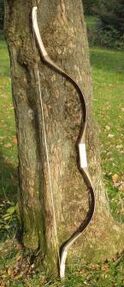(→Use) |
(→ Use) |
||
| (13 intermediate revisions by 7 users not shown) | |||
| Line 1: | Line 1: | ||
| − | [[File:Composite bow.jpg|thumb|124px|right|A Modern day Hunnic composite bow recreation]] The |
+ | [[File:Composite bow.jpg|thumb|124px|right|A Modern day Hunnic composite bow recreation]] The '''Hunnic Composite Bow''' was a recurve bow used by the Hunnic Empire, annihilation by archery. It was the long-range weapon of [[Attila the Hun]]. |
| − | '''Hunnic Composite Bow''' was a recurve bow used by the Hunnic Empire. It was the long-range weapon of [[Attila the Hun]]. |
||
==Description== |
==Description== |
||
The composite bow was made from several materials as opposed to a single piece of wood. When strung, the ends of the bow curve away from the archer. The bow typically has horn on the belly (the side of the bow facing the archer) and sinew on the back (the side of the bow facing the target). |
The composite bow was made from several materials as opposed to a single piece of wood. When strung, the ends of the bow curve away from the archer. The bow typically has horn on the belly (the side of the bow facing the archer) and sinew on the back (the side of the bow facing the target). |
||
| + | ===Stats=== |
||
| + | *4 feet |
||
| + | *Wood & Bone Bow |
||
| + | *Iron-Tipped Arrows |
||
| − | ==Use== |
+ | == Use== |
| ⚫ | |||
| + | The Parthians developed a strategy to supply their armies with wagons or caravans of camels to maintain ammunition for the horsemen. The Battle of Carrhae on May 6th 53 BC is an example of this strategy in effect, which managed to overwhelm the Roman armies despite their [[Scutum]] shields blocking the majority of the arrows. |
||
| ⚫ | |||
| + | |||
| + | As seen in The Second Battle of Lechfeld in 955 AD, Horseback Archery had several flaws. The Magyar (decedents of the Huns) were unable to maneuver due to dense forests on their flanks. Heavy rain also created mud, which slowed the horses further, and made bows difficult to use as the strings became too damp. |
||
[[Category:Ancient Weapons]] |
[[Category:Ancient Weapons]] |
||
[[Category:Weapons]] |
[[Category:Weapons]] |
||
[[Category:Bows]] |
[[Category:Bows]] |
||
[[Category:Projectile Weapons]] |
[[Category:Projectile Weapons]] |
||
| − | [[Category: |
+ | [[Category:Long Ranged Weapon]] |
| + | [[Category:Edge Weapons]] |
||
Revision as of 19:34, 15 July 2019

A Modern day Hunnic composite bow recreation
The Hunnic Composite Bow was a recurve bow used by the Hunnic Empire, annihilation by archery. It was the long-range weapon of Attila the Hun.
Description
The composite bow was made from several materials as opposed to a single piece of wood. When strung, the ends of the bow curve away from the archer. The bow typically has horn on the belly (the side of the bow facing the archer) and sinew on the back (the side of the bow facing the target).
Stats
- 4 feet
- Wood & Bone Bow
- Iron-Tipped Arrows
Use
The main advantage of the composite bow is that it delivers greater power for the same length as a simple bow, so a shorter composite bow has the same power as a much longer simple bow. The smaller size makes it ideal for use at horseback, an important part of Hunnic warfare.
The Parthians developed a strategy to supply their armies with wagons or caravans of camels to maintain ammunition for the horsemen. The Battle of Carrhae on May 6th 53 BC is an example of this strategy in effect, which managed to overwhelm the Roman armies despite their Scutum shields blocking the majority of the arrows.
As seen in The Second Battle of Lechfeld in 955 AD, Horseback Archery had several flaws. The Magyar (decedents of the Huns) were unable to maneuver due to dense forests on their flanks. Heavy rain also created mud, which slowed the horses further, and made bows difficult to use as the strings became too damp.